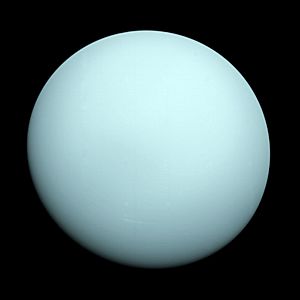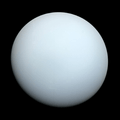Atmosphere of Uranus facts for kids
The atmosphere of Uranus is mostly made up of hydrogen and helium. It also has smaller amounts of other gases like methane. The lower part of the atmosphere contains icy materials such as water, ammonia, and methane. The upper atmosphere has very few heavy gases because it is extremely cold. In fact, Uranus's atmosphere is the coldest of all the planets in our Solar system. Its temperature can drop as low as 49 K (which is about -224 degrees Celsius or -371 degrees Fahrenheit)!
Contents
What is Uranus's Atmosphere Made Of?
Uranus is a giant gas planet, and its atmosphere is a thick blanket of gases. The main ingredients are hydrogen and helium, just like the Sun and other gas giants.
Gases and Layers
Below the main hydrogen and helium, you'll find layers of other gases. These include methane, ammonia, and water vapor. These gases are often called "ices" because they freeze at very cold temperatures. Scientists divide Uranus's atmosphere into different layers, much like Earth's. These layers include the troposphere, stratosphere, and thermosphere. Each layer has different temperatures and gas mixtures.
Why is it Blue?
Uranus has a beautiful blue-green color. This color comes from the methane gas in its atmosphere. Methane absorbs red light from the Sun and reflects blue and green light back into space. This is why Uranus looks so distinct from other planets.
How Cold is Uranus's Atmosphere?
Uranus holds the record for the coldest planetary atmosphere in our solar system. This extreme cold is a key feature of the planet.
The Coldest Planet
The temperature in Uranus's atmosphere can reach an incredibly low 49 Kelvin. To give you an idea, 0 Kelvin is absolute zero, the coldest possible temperature. This means Uranus is super, super cold! This low temperature affects how gases behave and how clouds form on the planet.
Winds and Weather on Uranus
Even though Uranus looks calm and featureless, it has strong winds and some interesting weather patterns.
Fast Winds and Few Clouds
Uranus has very fast winds, especially near its equator. These winds can blow at speeds of up to 900 kilometers per hour (about 560 miles per hour)! Unlike Jupiter or Saturn, Uranus doesn't have many visible storm systems or bands of clouds. This is partly because of its extreme cold and the way its atmosphere is structured. However, scientists have observed some bright clouds and storm activity, especially when the planet is closer to the Sun during its long orbit.
Images for kids
-
Temperature profiles in the stratosphere and thermosphere of Uranus. The shaded area is where hydrocarbons are concentrated.





